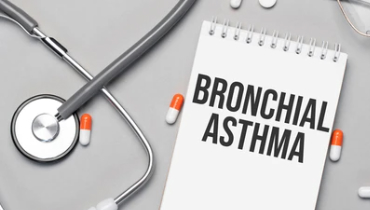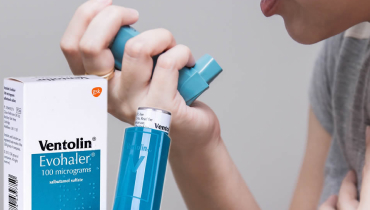Chronic bronchitis as one of the most common diseases of the lower respiratory tract is a hot topic for discussion. In recent years, it has been considered within the framework of the initial stage of COPD (chronic obstructive pulmonary disease), but this article will focus on non-obstructive chronic bronchitis, that is, that phase of the disease when there is no deformity and impaired bronchial patency, and pathological changes are still present. partially reversible.
So, chronic non-obstructive bronchitis is a widespread, steadily progressive inflammatory process with the involvement of the bronchial tree arising from the impact of damaging factors, exacerbating at least 2-3 times a year for two or more years in a row. The disease affects mainly adults after 45 years, more often males. In pediatric practice, chronic bronchitis is rare, mainly in children with abnormalities in the development of the respiratory system, so below we will consider the causes, symptoms and treatment of chronic bronchitis in adults.
In order to better understand how chronic bronchitis manifests itself and how it is treated, we will consider the morphological aspects of the development of the disease. Normally, the bronchi consist of a fibro-cartilaginous framework, a muscle layer, a submucosa and a mucous membrane lining them from the inside. The mucous membrane of the bronchi is represented by a prismatic ciliated epithelium, consisting of ciliated cells (perform the function of evacuating foreign particles and sputum from the respiratory tract) and goblet cells (producing specific protective mucus that does not allow harmful agents to penetrate the mucous membrane). Outside, the bronchi are “braided” by a network of blood and lymphatic vessels, nerves and small lymph nodes.

Due to the destructive effect on the mucous membrane of the bronchi of various infectious, physical and chemical factors, it hypertrophies, the work of the cilia of the ciliated epithelium is disrupted, hypersecretion of mucus by goblet cells occurs, the consistency of the secret itself changes – it becomes thick and viscous. This leads to a violation of the evacuation and barrier function of the mucous membrane, the sputum stagnates in the bronchi. Such changes in the mucous membrane favor the penetration of pathological microorganisms into the bronchus, therefore, bacterial infection is a frequent companion of chronic bronchitis. With the continued action of pathological factors, hypertrophy turns into atrophy – the mucous membrane becomes thinned, overly sensitive to substances contained in the flow of inhaled air.
Subsequently, the submucosa and smooth muscles of the bronchi are involved in the process – their thickening (hypertrophy) occurs. In the later stages of the disease, with the transition of non-obstructive chronic bronchitis to COPD, the structure of the fibro-cartilaginous wall begins to change – there is a deformation of the bronchi, narrowing of their lumen.
Among the most common causes of chronic bronchitis are the following.
- Tobacco smoking is the most common factor in the onset of the disease. Tobacco smoke contains a lot of substances destructive to the mucous membrane of the respiratory tract (benzopyrene, vinyl chloride, formaldehyde), and in addition, it triggers the processes of lipid peroxidation, leading to damage to the cells of the ciliated epithelium.
- Exposure to pollutants (substances that pollute the atmospheric air due to industrial and transport emissions) – sulfur oxides, nitrogen dioxide, oil refined products, etc.
- Direct (more often during professional activities) contact with toxic chemicals (chlorine, ammonia vapors) and industrial dust (asbestos and coal dust, silicon dioxide).
- Recurrent acute respiratory diseases. The tendency to their frequent occurrence is often due to living in unfavorable climatic conditions.
Chronic bronchitis diagnostics
Clinical manifestations of non-obstructive chronic bronchitis without exacerbation of the disease are rather scarce. The leading symptom is a cough of low intensity, dry or with scanty mucous sputum, which occurs mainly in the morning hours, which until a certain moment is not even perceived by the patient as a manifestation of the disease. The cough is of a reflex nature: the altered mucosal epithelium loses its drainage function, and the body mechanically tries to remove the sputum stagnant in the bronchi. Shortness of breath in non-obstructive chronic bronchitis, as a rule, does not happen – it occurs already with a narrowing of the lumen of the bronchus due to its deformation (with COPD) or severe inflammatory edema.
When examining a patient during a period of remission, a doctor, during auscultation of the lungs, can hear a change in the nature of breathing: normally, a full inhalation and 1/3 of an exhalation are heard, with bronchitis, the exhalation is lengthened and auscultated to the end, such breathing is called hard. On the roentgenogram, changes may be absent or manifest as an increase in the pulmonary pattern. When performing spirography (a method that determines lung function by measuring tidal volumes and flows), pathological changes are also not recorded.
The disease acquires vivid manifestations during an exacerbation, provoked by a combination of factors such as decreased immunity, hypothermia and respiratory infection. In this case, the infectious process may initially have a viral nature, but due to the existing changes in the structure of the bronchial mucosa, in 2-3 days, in most cases, the bacterial flora joins.
Symptoms during exacerbation of bronchitis
- Increase in the intensity and frequency of cough, change in its nature. He can become spastic, paroxysmal, obsessive.
- Changes in the properties of sputum. It becomes thick and viscous, and when the bacterial flora is attached, it becomes purulent.
- Shortness of breath. It does not always accompany non-obstructive bronchitis, but it can occur due to pronounced edema of the mucous membrane and obstruction (blockage) of the lumen of the bronchi with viscous sputum.
- An increase in temperature during an exacerbation of the process is more often noted to subfebrile numbers (below 38 ° C).
- Symptoms of general intoxication (muscle weakness, sweating, headache) with bronchitis are much less pronounced than with pneumonia and other inflammatory and infectious diseases of the lower respiratory tract.
When examining a patient with an exacerbation of bronchitis, the doctor, in addition to hard breathing, can hear in the lungs a lot of scattered dry and various moist rales.
On the roentgenogram, an increase in the pulmonary pattern will be visualized (normally it is barely distinguishable in the peripheral regions, and with bronchitis it is clearly visible throughout the pulmonary field).
During spirography, there may be no changes in respiratory function indicators, but if, due to significant inflammatory edema, broncho-obstructive syndrome develops, then there is a decrease in the vital capacity of the lungs and the speed indicators of external respiration.
In blood tests, moderate nonspecific inflammatory changes are noted (an increase in the level of leukocytes with a neutrophilic shift of the leukoformula, erythrocyte sedimentation rate, C-reactive protein).
Given the development of respiratory failure during the period of exacerbation of bronchitis, a change in the gas composition of the blood can be determined. A decrease in oxygen saturation (the ratio of the amount of oxygenated hemoglobin to the total amount of hemoglobin in the blood) can be determined both in the laboratory and using an electronic device that is worn on the patient’s finger – a pulse oximeter. Normally, this figure is 96% or more.
It is advisable to conduct microscopic and microbiological examinations of sputum, since they help the doctor decide how to treat chronic bronchitis.
The first method allows you to determine the nature of the inflammation (catarrhal, purulent), the second – the causative agent of the infection and its sensitivity to antibiotics of a different spectrum.
As an auxiliary method of research, fibrobronchoscopy can be performed, which allows you to visually assess changes in the mucous membrane, the nature of the secretion and make a sampling of bronchial lavage for cytological and bacteriological analysis.

Chronic bronchitis diagnostics
Clinical manifestations of non-obstructive chronic bronchitis without exacerbation of the disease are rather scarce. The leading symptom is a cough of low intensity, dry or with scanty mucous sputum, which occurs mainly in the morning hours, which until a certain moment is not even perceived by the patient as a manifestation of the disease. The cough is of a reflex nature: the altered mucosal epithelium loses its drainage function, and the body mechanically tries to remove the sputum stagnant in the bronchi. Shortness of breath in non-obstructive chronic bronchitis, as a rule, does not happen – it occurs already with a narrowing of the lumen of the bronchus due to its deformation (with COPD) or severe inflammatory edema.
When examining a patient during a period of remission, a doctor, during auscultation of the lungs, can hear a change in the nature of breathing: normally, a full inhalation and 1/3 of an exhalation are heard, with bronchitis, the exhalation is lengthened and auscultated to the end, such breathing is called hard. On the roentgenogram, changes may be absent or manifest as an increase in the pulmonary pattern. When performing spirography (a method that determines lung function by measuring tidal volumes and flows), pathological changes are also not recorded.
The disease acquires vivid manifestations during an exacerbation, provoked by a combination of factors such as decreased immunity, hypothermia and respiratory infection. In this case, the infectious process may initially have a viral nature, but due to the existing changes in the structure of the bronchial mucosa, in 2-3 days, in most cases, the bacterial flora joins.
Symptoms during exacerbation of bronchitis
- Increase in the intensity and frequency of cough, change in its nature. He can become spastic, paroxysmal, obsessive.
- Changes in the properties of sputum. It becomes thick and viscous, and when the bacterial flora is attached, it becomes purulent.
- Shortness of breath. It does not always accompany non-obstructive bronchitis, but it can occur due to pronounced edema of the mucous membrane and obstruction (blockage) of the lumen of the bronchi with viscous sputum.
- An increase in temperature during an exacerbation of the process is more often noted to subfebrile numbers (below 38 ° C).
- Symptoms of general intoxication (muscle weakness, sweating, headache) with bronchitis are much less pronounced than with pneumonia and other inflammatory and infectious diseases of the lower respiratory tract.
When examining a patient with an exacerbation of bronchitis, the doctor, in addition to hard breathing, can hear in the lungs a lot of scattered dry and various moist rales.
On the roentgenogram, an increase in the pulmonary pattern will be visualized (normally it is barely distinguishable in the peripheral regions, and with bronchitis it is clearly visible throughout the pulmonary field).
During spirography, there may be no changes in respiratory function indicators, but if, due to significant inflammatory edema, broncho-obstructive syndrome develops, then there is a decrease in the vital capacity of the lungs and the speed indicators of external respiration.
In blood tests, moderate nonspecific inflammatory changes are noted (an increase in the level of leukocytes with a neutrophilic shift of the leukoformula, erythrocyte sedimentation rate, C-reactive protein).
Given the development of respiratory failure during the period of exacerbation of bronchitis, a change in the gas composition of the blood can be determined. A decrease in oxygen saturation (the ratio of the amount of oxygenated hemoglobin to the total amount of hemoglobin in the blood) can be determined both in the laboratory and using an electronic device that is worn on the patient’s finger – a pulse oximeter. Normally, this figure is 96% or more.
It is advisable to conduct microscopic and microbiological examinations of sputum, since they help the doctor decide how to treat chronic bronchitis.
The first method allows you to determine the nature of the inflammation (catarrhal, purulent), the second – the causative agent of the infection and its sensitivity to antibiotics of a different spectrum.
As an auxiliary method of research, fibrobronchoscopy can be performed, which allows you to visually assess changes in the mucous membrane, the nature of the secretion and make a sampling of bronchial lavage for cytological and bacteriological analysis.
How to treat chronic bronchitis in adults
Treatment of chronic non-obstructive bronchitis without exacerbation of the process does not imply active drug therapy. Basically, these are preventive measures aimed at preventing the recurrence of the disease.
- Carrying out therapeutic breathing exercises.
- Courses of chest drainage massage. This type of massage helps prevent stagnation of phlegm in the bronchi and strengthen the auxiliary respiratory muscles, but it can only be performed by a specialist with a medical education who has been trained in this technique.
- Carrying out courses of anti-inflammatory herbal medicine. It has long been believed that decoctions and infusions of coltsfoot, wild rosemary, licorice root, as well as inhalation of solutions based on eucalyptus and chamomile help to reduce the degree of inflammation and normalize the viscosity of sputum. Preparations based on herbal ingredients are actively prescribed by doctors, and patients are often perceived as an effective means of helping to get rid of chronic bronchitis. However, evidence-based medicine questions the advisability of using these drugs in the treatment of bronchitis, due to the lack of sufficient data on their effectiveness based on research results.
- Physiotherapy procedures. Halotherapy, inductothermy, UHF, magnetotherapy, heat therapy, inhalation aerosol therapy – this is an incomplete list of physiotherapeutic methods that help answer the question of how to prevent and treat chronic bronchitis. Thermal exposure to the nasal cavity during seasonal outbreaks of SARS and influenza helps to destroy the virus and prevent the development of infection. It is worth mentioning here the compact magnetic therapy and heat therapy devices for home use, which allow the patient to independently carry out procedures with the required frequency, without wasting time visiting medical institutions.
- Prevention of respiratory viral and bacterial infections. It means the preventive use of antiviral agents and immunomodulators, the use of personal protective equipment (respirators, masks) during the season of increased ARVI incidence, as well as hardening and preventive vaccinations against pneumococcal and hemophilic infections.
- Elimination or reduction of contact with negative environmental factors, implying the use of personal respiratory protection, the use of air purifiers and humidifiers and, of course, smoking cessation. It is no coincidence that drugs used for nicotine addiction (Varenicline, Cytisine) are included in the federal standard for the treatment of chronic bronchitis.
- Ventolin tablets or aerosol with the active ingredient salbutamol. It has a pronounced bronchodilator effect, preventing or stopping bronchial spasms, reduces resistance in the airways.
Compliance with preventive measures and a healthy lifestyle are often the answer to the question “how to get rid of exacerbations of chronic bronchitis forever.”
But how to cure chronic bronchitis, if an exacerbation of the disease has arisen?
Antitussive drugs are prescribed without fail for the treatment of exacerbation of chronic bronchitis in adults. All antitussives can be divided into 2 main groups.
- Preparations of peripheral action. These include mucolytics (thinning phlegm) and mucokinetics (improving the evacuation of phlegm from the bronchi) of synthetic (ambroxol, bromhexine, acetylcysteine) and plant (licorice, thermopsis) origin. These drugs are available in the form of syrups, tablets, solutions for inhalation.
- Preparations of central action (butamirate, codeine, glaucine). Their action is based on suppressing the cough reflex by blocking the cough center of the medulla oblongata. They are prescribed in a short course in extreme cases, when a painful spastic cough significantly reduces the quality of human life, and only in the absence of signs of hyperproduction of sputum, since with a decrease in the cough reflex, its evacuation worsens with the occurrence of obstruction (blockage) of the bronchi. These medicines are dispensed in the pharmacy exclusively with a doctor’s prescription.
Effective treatment of chronic bronchitis in the presence of signs of bacterial infection (fever for more than three days in a row, purulent sputum, inflammatory changes in blood tests, isolation of pathogenic microorganisms in bacteriological culture of sputum) also implies systemic antibiotic therapy. Inhibitor-protected penicillins are recommended as drugs of choice, since they have good activity as the main causative agents of exacerbation of bronchitis – pneumococcus and Haemophilus influenzae. In case of intolerance to these drugs or the confirmed presence of atypical microflora, an alternative treatment is drugs of the macrolide group.
In cases where the first-line therapy was ineffective, the patient was hospitalized with a severe form of bronchitis in the hospital or the presence of Pseudomonas aeruginosa infection was bacteriologically confirmed, respiratory fluoroquinolones (Levofloxacin, Moxifloxacin) or 3rd generation cephalosporins (Cefotaxime, Cefoperazone) are prescribed. It is advisable to perform a microbiological examination of sputum before taking antibiotics in order to adjust the treatment based on its result, taking into account the sensitivity of the isolated microorganisms.
How to cure exacerbation of chronic bronchitis
In the case of the development of broncho-obstructive syndrome against the background of an exacerbation of the process, a short course of inhaled β2-agonists (Salbutamol, Formoterol) or M-anticholinergics (Ipratropium bromide) can be carried out. These drugs eliminate bronchospasm, normalize the lumen of the bronchus and, accordingly, facilitate breathing.
In cases where the drainage function of the bronchi is impaired and antibiotics cannot stop the purulent process for a long time, a sanitation fibrobronchoscopy can be performed as an aid. This manipulation helps to mechanically evacuate purulent sputum from the bronchi, treat the mucous membrane with local antiseptics, and also take wash water for bacteriological analysis.
How can chronic bronchitis in adults be treated during an exacerbation: additional methods
In addition to drug therapy, the same methods are successfully used as for the prevention of the disease: massage and physiotherapy exercises can be prescribed to improve drainage function of the bronchi (in the absence of respiratory failure and fever), inhalation therapy helps to normalize the rheological properties of sputum, physiotherapy – to reduce the activity of inflammation. In the phase of decay of exacerbation, it is advisable to carry out magnetotherapy, which accelerates recovery and prevents relapses of the disease.
Having considered the symptoms and treatment of chronic bronchitis, I would like to note that it will be at least difficult to cure chronic bronchitis “forever” if the factors causing the disease are not eliminated. Therefore, it is very important to lead a healthy lifestyle and be aware of the harmful effects of smoking.












I have received my package. thank you. Will use my discount for further orders! Thanks.
I have received my package and it is in fine condition. Thanks.
Hi i have received my package. Thank you!